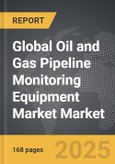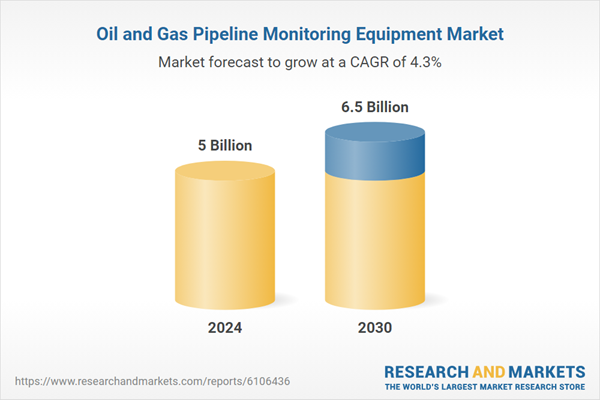Global Oil and Gas Pipeline Monitoring Equipment Market - Key Trends & Drivers Summarized
Why Has Pipeline Monitoring Become Central to Oil and Gas Infrastructure?
Pipeline monitoring equipment plays a critical role in ensuring safe, efficient, and uninterrupted transportation of oil and gas across long distances. As global pipeline networks expand and age, risks related to leaks, corrosion, mechanical damage, and unauthorized tapping have increased. Failures in these systems can result in severe environmental, safety, and financial consequences. Continuous monitoring using advanced sensing technologies has become essential for early detection of anomalies and swift response to operational issues.Modern pipeline systems now rely on a mix of inline inspection tools, pressure sensors, acoustic detectors, and fiber optic sensing systems to maintain real-time situational awareness. These tools enable operators to detect issues such as pressure variations, temperature fluctuations, and structural degradation before they escalate into critical failures. Adoption of such equipment is no longer driven by compliance alone but by the broader goal of minimizing downtime, reducing operational costs, and protecting surrounding communities and ecosystems.
How Are Technologies Reshaping Pipeline Surveillance and Maintenance?
Technological advances are significantly enhancing the precision, responsiveness, and coverage of pipeline monitoring solutions. Distributed fiber optic sensing systems allow operators to monitor temperature and strain along an entire pipeline route, providing early warnings of leakages, ground movements, and unauthorized access. Smart pigs equipped with ultrasonic, magnetic flux leakage, and inertial measurement sensors can assess pipeline integrity from the inside, identifying corrosion, cracks, and deformation with high accuracy.Unmanned aerial vehicles (UAVs), satellite imaging, and ground-based remote sensors are being used for surface-level monitoring, especially in difficult terrains or politically sensitive areas. Integration with SCADA systems and data analytics platforms allows operators to process large volumes of monitoring data in real time, enabling predictive maintenance and improving decision-making. These innovations are extending inspection intervals, reducing manual interventions, and enhancing risk mitigation across upstream and midstream networks.
What End-Use and Regulatory Trends Are Driving Equipment Demand?
Increasing regulatory pressure to improve safety and environmental performance is a major driver of monitoring equipment deployment. Governments across regions are mandating stricter inspection intervals and detailed integrity management plans, especially in high-consequence areas. Compliance requirements are pushing operators to adopt advanced leak detection systems, automated shutdown mechanisms, and tamper detection technologies to reduce the probability of incidents.The shift toward remote pipeline operations in extreme environments, such as Arctic zones, deserts, and offshore installations, is further boosting demand for automated, resilient, and low-maintenance monitoring systems. Pipeline expansions to support new LNG terminals, unconventional oil production, and cross-border transmission projects are creating new opportunities for equipment manufacturers. Asset owners in aging pipeline regions are also retrofitting existing infrastructure with modern monitoring solutions to extend operational life and meet current safety standards.
What Factors Are Driving Growth in the Pipeline Monitoring Equipment Market?
Growth in the pipeline monitoring equipment market is driven by several factors. Expansion of oil and gas transmission infrastructure in Asia-Pacific, North America, and the Middle East is increasing demand for comprehensive surveillance and integrity solutions. Rising threats of pipeline sabotage, third-party damage, and environmental incidents are accelerating adoption of tamper detection and leak monitoring technologies. Technological advancements in fiber optic sensing, inline inspection tools, and remote surveillance platforms are improving operational accuracy and reducing inspection costs. Integration of pipeline monitoring with centralized SCADA systems and cloud-based analytics is enhancing predictive capabilities and operational efficiency. Growth in unconventional hydrocarbon production and LNG transportation projects is also supporting demand for high-sensitivity and high-reliability equipment. Additionally, increased regulatory scrutiny and the need to modernize aging infrastructure are creating a steady replacement market for next-generation monitoring tools.Report Scope
The report analyzes the Oil and Gas Pipeline Monitoring Equipment market, presented in terms of market value (US$). The analysis covers the key segments and geographic regions outlined below:- Segments: Component (Hardware Component, Software Component); Type (Vibration Monitoring Equipment, Thermal Monitoring Equipment, Lubrication Monitoring Equipment, Other Types).
- Geographic Regions/Countries: World; United States; Canada; Japan; China; Europe (France; Germany; Italy; United Kingdom; and Rest of Europe); Asia-Pacific; Rest of World.
Key Insights:
- Market Growth: Understand the significant growth trajectory of the Hardware Component segment, which is expected to reach US$4.4 Billion by 2030 with a CAGR of a 5%. The Software Component segment is also set to grow at 2.9% CAGR over the analysis period.
- Regional Analysis: Gain insights into the U.S. market, valued at $1.3 Billion in 2024, and China, forecasted to grow at an impressive 4.2% CAGR to reach $1 Billion by 2030. Discover growth trends in other key regions, including Japan, Canada, Germany, and the Asia-Pacific.
Why You Should Buy This Report:
- Detailed Market Analysis: Access a thorough analysis of the Global Oil and Gas Pipeline Monitoring Equipment Market, covering all major geographic regions and market segments.
- Competitive Insights: Get an overview of the competitive landscape, including the market presence of major players across different geographies.
- Future Trends and Drivers: Understand the key trends and drivers shaping the future of the Global Oil and Gas Pipeline Monitoring Equipment Market.
- Actionable Insights: Benefit from actionable insights that can help you identify new revenue opportunities and make strategic business decisions.
Key Questions Answered:
- How is the Global Oil and Gas Pipeline Monitoring Equipment Market expected to evolve by 2030?
- What are the main drivers and restraints affecting the market?
- Which market segments will grow the most over the forecast period?
- How will market shares for different regions and segments change by 2030?
- Who are the leading players in the market, and what are their prospects?
Report Features:
- Comprehensive Market Data: Independent analysis of annual sales and market forecasts in US$ Million from 2024 to 2030.
- In-Depth Regional Analysis: Detailed insights into key markets, including the U.S., China, Japan, Canada, Europe, Asia-Pacific, Latin America, Middle East, and Africa.
- Company Profiles: Coverage of players such as Bharat Petroleum Corporation Ltd., BP plc, Chevron Corporation, China National Petroleum Corporation (CNPC), Eni S.p.A. and more.
- Complimentary Updates: Receive free report updates for one year to keep you informed of the latest market developments.
Some of the 33 companies featured in this Oil and Gas Pipeline Monitoring Equipment market report include:
- ABB Ltd
- Atmos International (Pure Technologies)
- ClampOn AS
- Emerson Electric Co.
- FLIR Systems, Inc.
- Honeywell International Inc.
- Hifi Engineering
- KROHNE Group
- OptaSense Ltd. (Luna Innovations)
- Pentair plc
- Perma-Pipe International Holdings, Inc.
- PSI Software AG
- Pure Technologies Ltd. (Calgary)
- Schneider Electric SE
- Sensit Technologies
- Siemens AG
- Spectris Plc
- TTK Leak Detection
- Yokogawa Electric Corporation
- Xylem, Inc.
This edition integrates the latest global trade and economic shifts into comprehensive market analysis. Key updates include:
- Tariff and Trade Impact: Insights into global tariff negotiations across 180+ countries, with analysis of supply chain turbulence, sourcing disruptions, and geographic realignment. Special focus on 2025 as a pivotal year for trade tensions, including updated perspectives on the Trump-era tariffs.
- Adjusted Forecasts and Analytics: Revised global and regional market forecasts through 2030, incorporating tariff effects, economic uncertainty, and structural changes in globalization. Includes historical analysis from 2015 to 2023.
- Strategic Market Dynamics: Evaluation of revised market prospects, regional outlooks, and key economic indicators such as population and urbanization trends.
- Innovation & Technology Trends: Latest developments in product and process innovation, emerging technologies, and key industry drivers shaping the competitive landscape.
- Competitive Intelligence: Updated global market share estimates for 2025, competitive positioning of major players (Strong/Active/Niche/Trivial), and refined focus on leading global brands and core players.
- Expert Insight & Commentary: Strategic analysis from economists, trade experts, and domain specialists to contextualize market shifts and identify emerging opportunities.
Table of Contents
Companies Mentioned (Partial List)
A selection of companies mentioned in this report includes, but is not limited to:
- ABB Ltd
- Atmos International (Pure Technologies)
- ClampOn AS
- Emerson Electric Co.
- FLIR Systems, Inc.
- Honeywell International Inc.
- Hifi Engineering
- KROHNE Group
- OptaSense Ltd. (Luna Innovations)
- Pentair plc
- Perma-Pipe International Holdings, Inc.
- PSI Software AG
- Pure Technologies Ltd. (Calgary)
- Schneider Electric SE
- Sensit Technologies
- Siemens AG
- Spectris Plc
- TTK Leak Detection
- Yokogawa Electric Corporation
- Xylem, Inc.
Table Information
| Report Attribute | Details |
|---|---|
| No. of Pages | 168 |
| Published | December 2025 |
| Forecast Period | 2024 - 2030 |
| Estimated Market Value ( USD | $ 5 Billion |
| Forecasted Market Value ( USD | $ 6.5 Billion |
| Compound Annual Growth Rate | 4.3% |
| Regions Covered | Global |









